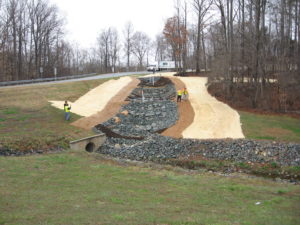Stormwater Best Management Practices, typically called Stormwater Control Measures (SCM), and sometimes referred to as BMP’s, are used to help control and treat stormwater runoff. There are many types of SCMs, each functioning in different ways. For instance, some SCMs temporarily detain runoff in ponds then slowly release it over time. Known as water quality ponds, this type of SCM is particularly useful for capturing runoff from large buildings and parking lots in order to protect the stream from large volumes of runoff which can cause stream bank erosion. Stormwater wetlands are another type of SCM which function similarly to detention ponds but tend to be shallower to allow for wetland plants to grow which can improve pollutant removal performance. Bioretention basins are another commonly used SCM and function by capturing stormwater runoff and allowing it to infiltrate through a layer of engineered sandy media underground. This type of SCM is outfitted with a french drain under the sand media which allows the filtered and cleansed runoff to discharge from the basin. Since bioretention basins only stay wet for a short period of time, this SCM can be landscaped with a variety of plants and thus be an attractive amenity for the area. Grassed swales are probably the most widely used SCMs, especially along roadways. These vegetated open channels are relatively low cost and easy to maintain. Swale SCMs treat stormwater by filtering the runoff through the grass and infiltrate a portion of it into the ground. Swales can also be used in combination with other types of SCMs for enhanced treatment. The SCMs described above are classified as structural SCMs because they have to be designed and built into the landscape typically at the time when the original development is built.
 A “retrofit” is a structural SCM that has been installed after – typically years after – the original development was constructed. Retrofits are installed wherever sufficient available space allows and are targeted for existing developments that either do not have adequate runoff treatment in place or would benefit from enhanced runoff treatment. While retrofitting an area with enhanced stormwater treatment is a great tool for improving the water quality of nearby streams, the practice tends to be significantly more costly than constructing SCMs concurrent with the original development. Additionally finding sufficient space to construct a retrofit SCM can be difficult, especially in highly urbanized areas. Therefore, another class of SCM is also very important to protect the health of local streams. These SCMs are called non-structural stormwater best management practices. Non-structural SCMs tend to function by preventing pollutants from contaminating stormwater runoff in the first place. In contrast structural SCMs treat stormwater in order to remove the pollutants already in the runoff. Non-structural SCMs are often town-wide programs such as those which encourage proper fertilizer application, pet waste pickup programs, urban forestry programs, and leaky septic tank replacement programs. Non-structural SCM programs encourage community involvement and help to enhance overall water quality within the watershed.
A “retrofit” is a structural SCM that has been installed after – typically years after – the original development was constructed. Retrofits are installed wherever sufficient available space allows and are targeted for existing developments that either do not have adequate runoff treatment in place or would benefit from enhanced runoff treatment. While retrofitting an area with enhanced stormwater treatment is a great tool for improving the water quality of nearby streams, the practice tends to be significantly more costly than constructing SCMs concurrent with the original development. Additionally finding sufficient space to construct a retrofit SCM can be difficult, especially in highly urbanized areas. Therefore, another class of SCM is also very important to protect the health of local streams. These SCMs are called non-structural stormwater best management practices. Non-structural SCMs tend to function by preventing pollutants from contaminating stormwater runoff in the first place. In contrast structural SCMs treat stormwater in order to remove the pollutants already in the runoff. Non-structural SCMs are often town-wide programs such as those which encourage proper fertilizer application, pet waste pickup programs, urban forestry programs, and leaky septic tank replacement programs. Non-structural SCM programs encourage community involvement and help to enhance overall water quality within the watershed.

